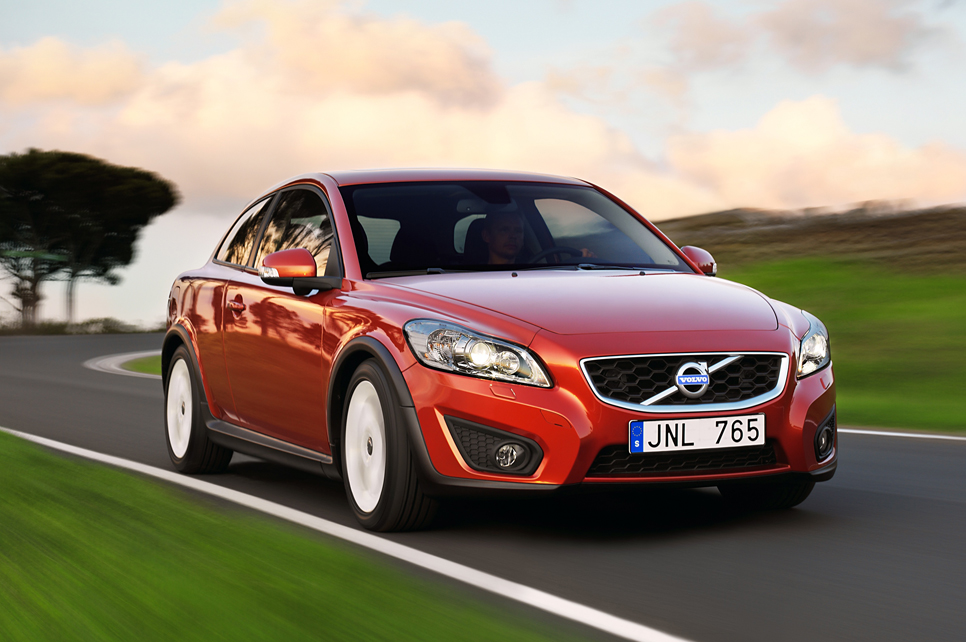The Clarkson review: Volvo C30 (2010)
 I know of very little in life that costs less than you think. The internet is one thing, obviously, and newspapers are another. Then there’s McDonald’s, which can sell you a double cheeseburger featuring expensive beef from British farms, some dill pickle slices, some cheese, some mustard and some proper Heinz tomato ketchup in a bun, in a heated restaurant with staff and loos and lighting, for £1.29. I do not know how that’s possible.
I know of very little in life that costs less than you think. The internet is one thing, obviously, and newspapers are another. Then there’s McDonald’s, which can sell you a double cheeseburger featuring expensive beef from British farms, some dill pickle slices, some cheese, some mustard and some proper Heinz tomato ketchup in a bun, in a heated restaurant with staff and loos and lighting, for £1.29. I do not know how that’s possible.
Mostly, though, everything is always more expensive than you think. I bought a glass of house wine at a restaurant the other day and it was £9.50. It wasn’t a particularly notable wine and it wasn’t a very big glass but nevertheless, with a tip, I got no change at all from a tenner.
Search for and buy a Volvo C30 on driving.co.uk
Then, you have handbags. If you buy your wife the sort of bag she wants, rather than the sort she will hit you with, it will cost you roughly a million pounds. About the same as a pair of Levi’s jeans. I bought a can of Coke the other day and it was a quid. A quid. For a can of Coke. It’s simply not possible. When I was a schoolboy, I would sometimes treat myself to a Twix bar on the way home from school. It cost 6d, which in new money is 2½p. Today a bar of chocolate is 10 bob. For 10 bob, I could have bought two Dinky cars.
Furniture is also fantastically expensive. So is flying. So are babysitters. And so is the cost of using your smartphone to access the internet while you are abroad. I checked the online newspapers every day on my recent holiday and the bill for doing so was about fifteen million pounds. Cars are especially expensive.
In my mind, a Volkswagen Golf should cost around £6,000. But, in fact, a normal 2-litre diesel is around £20,000. And further up the scale, things have gone mad. A Range Rover. That was about £2,000 when it was launched. Now, the cheapest is more than £67,000. If bread had been on a similar upward curve, a loaf would today cost more than France.
Not that long ago, a really exotic car with a big badge and lots of speed cost around £60,000, but then, when no one was looking, they all leapt up to three times that. Only last year, I said that £160,000 for an Aston Martin DBS was absurd. Today, with it being so easy to end up paying £195,000 for a Mercedes SLS AMG, it looks good value. And that’s before we get to the Lexus LFA.
Oh, I know it’s a technical showcase and I’m aware that its V10 engine is one of the all-time great powerplants but what sentient being is going to say, “Yes, £336,000 for a Lexus. Very reasonable”? For the car, £336,000 might be fine. But for a car with Lexus written down the side? No. It’d be like paying £20m for a Fabergé egg with a Ratners badge.
Then you have the Ferrari 458. The baby in the Ferrari range should cost £100,000. That feels about right. But the Italia is about £170,000, plus another £170,000 to buy a replacement after the first one burns to a crisp. Now £170,000 for the small Ferrari is madness. It’s not allowed.
Of course, there are cheap cars, but they are cheap for a reason and the reason is: they are horrid. And if something is horrid, then any price tag, no matter how low, makes it bad value. In fact, there are only three cars currently on sale which, I think, are cheaper than you might imagine.
One is the Maserati Quattroporte, one is the VW Scirocco and one is the subject of this morning’s missive: the Volvo C30. It looks a bit like the old Volvo P1800ES and those of us who are old enough will remember this was a car with much kudos. Based on the car used in The Saint, it was a three-door estate in the mould of Lancia’s lovely HPE and Reliant’s not quite so lovely Scimitar. It was also quite expensive. And so you imagine that the new car will be quite expensive, too. But it isn’t.
The entry-level model is £15,605, which means you are getting a lot of style and much panache for the price of a top-end 1.3-litre Vauxhall Corsa diesel. The car I drove was a range-topping T5. That comes with the same 2.5-litre five-cylinder turbo engine you get in a Ford Focus ST, which means 227 horsepower, 0-60mph in 6.2 seconds and a top speed of 149mph. These are impressive numbers in a car that costs from just £21,405. Sure, the Ford on which the Volvo is based is about £1,000 less, but the Ford is — how can I put this? — a bit vulgar.
It is a car for people who have ankle bracelets whereas the Volvo is restrained and tasteful and very, very pretty. There is, however, a price to pay for that prettiness. The C30 is about as useful as a wooden potato. Volvo says that the rear seats will almost never be used and that most owners will simply fold them away and use the cargo space instead. True enough.
And sure, the boot is big enough to smuggle a man into Dover, but because that stylish glass opening is so small, you’d have to chop him into small pieces before you posted him in there. It’d be the same story with shopping. The C30 badge makes this car sound a bit like a transport plane but, really, it isn’t one.
Instead, you need to think of it as a sports car that happens to have a hatchback. And if you do that, you’re in for a bit of a disappointment because it isn’t even on nodding terms with the man who lives next door to sportscarness. If you really make the effort and work the manual six-speed box, you can make it go quite fast but you always get the sense it’d rather be at home with its cat.
On a motorway, for instance, the speed at which it settles, if you are not really concentrating, is 60. In the corners, it feels squodgy. I realise that squodgy is not a term found very often in engineering but that’s what it feels like. The steering is rubbery, the responses dull, and if you try to go quickly, it all gets a bit wayward.
It’s almost as though the shock absorbers are full of strong opiates. I didn’t mind this too much, if I’m honest. Buying a Volvo and expecting it to be a razor-sharp screamer would be like buying a banana and taking it back to the shop because it can’t pick up Radio 4.
I don’t mind the lack of practicality, either. That’s the price you pay for those looks. What I do mind is the lack of toys. Only when you’ve pushed the seat back by hand and consulted a road map, because there’s no sat nav, do you realise why this car is so cheap. It really is four wheels and a seat.
Strangely, however, it does have cruise control, perhaps the most useless gizmo of all. In Britain you’d be better off with an on-board aquarium. However, the small amount of stuff you do get seems to be well put together, as befits anything made in Belgium — a byword for quality and attention to detail. You may have noticed, if you read this column regularly, that I’ve spent rather more time talking about the car than is usual. There’s a good reason for this. It confuses me. On every measurable level, it is not much good, and even on the safety front — Volvo’s traditional battleground — every other car maker has caught up. And yet, I like it. It like its smallness. I love the way it looks. And there’s something deliciously obtuse about buying a three-door estate car made in Belgium. So, is it any good? No. Would I consider buying one? Yes. Definitely.
Search for and buy a Volvo C30 on driving.co.uk





